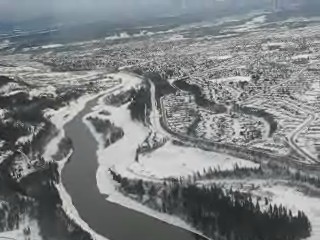Minister in Charge of Public Safety On His Way to Prince George
By 250 News
Prince George, B.C. - Minister for Public Safety and Solicitor General John Les, will be arriving in Prince George late this afternoon to meet with residents and businesses impacted by the flooding from the ice jam on the Nechako River.
(at right, the latest video of the ice jam on a helicter flight heading east towards the Nechako and Fraser River confluence. click on photo to see the video, which is courtesy www.flightsource.ca and was taken yesterday.)
"The Province has a role to lolok at all options to break up the ice and get the water flowing" says Agriculture Minister and MLA for Prince George North, Pat Bell, "Certainly the ice breaker option that the Opinion250 reader has discovered, looks very interesting and officials are exploring that".
Tomorrow, Premier Gordon Campbell will arrive to tour the area and get an update on mid and long term strategies.
"I don’t think this is a one time problem" says Bell, "I think we can expect to see this kind of jam and flooding for the next 10 -15 years so we have to develop some long term solutions."
Previous Story - Next Story
Return to Home










Well, finally some good news thanks to the input from a person who wouldn't just *wait for spring* - a Opinion250 reader!
Three Cheers!